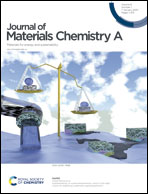Shuttle confinement of lithium polysulfides in borocarbonitride nanotubes with enhanced performance for lithium–sulfur batteries†
Abstract
The sluggish redox kinetics and severe shuttle effect remain the key issues for lithium–sulfur (Li–S) batteries, and result in their inferior electrochemical properties. In this contribution, metal-free borocarbonitride nanotubes (BCNNTs) are readily fabricated by pyrolysis of an organic precursor and used as the sulfur host material in Li–S batteries for the first time. The unique nanotube structure and the existence of B and N endow BCNNTs with high surface area, excellent stability, improved electrical conductivity, and they show efficient physical and chemical anchoring and conversion of lithium polysulfides (LiPSs). By combining the fast Li+ and electron transportation, a Li–S battery with superior rate and cycling performance is achieved, which is consistent with the results of the density functional theory (DFT) calculations. Typically, BCNNT based Li–S batteries show prominent cycling life with a capacity degradation of 0.041% per cycle (1000 cycles) and a high sulfur loading of 5.3 mg cm−2. This work defines an efficacious strategy to restrain the shuttle effect of LiPSs and shed light on the great potential of metal-free BCNNTs in Li–S batteries.



 Please wait while we load your content...
Please wait while we load your content...